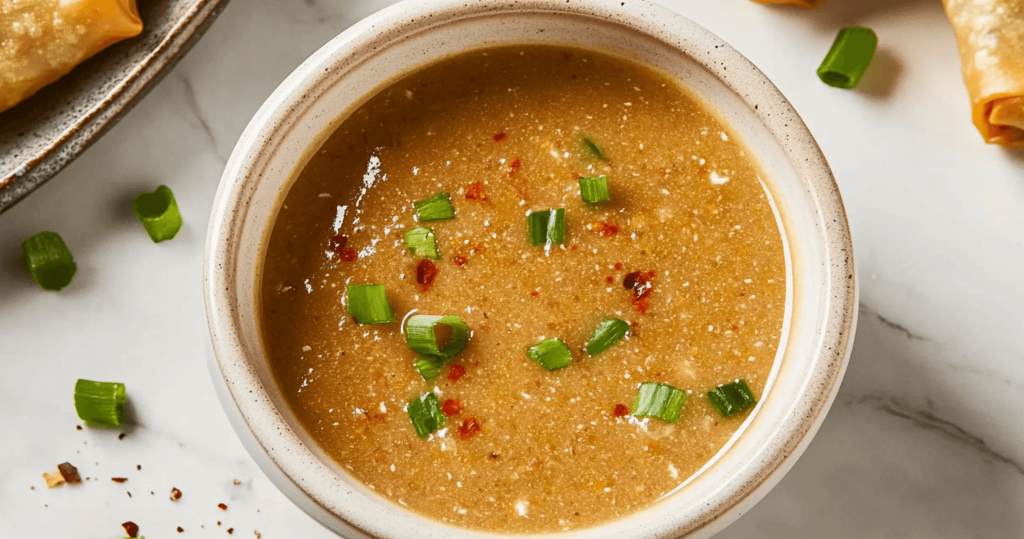Egg roll sauce is the perfect complement to crispy, savory egg rolls, adding an extra layer of flavor that enhances the overall dining experience. Whether you prefer a classic soy-based sauce or something with a bit more kick, making your own egg roll sauce at home allows you to customize the flavors to your liking. This guide will walk you through everything you need to know to create a delicious egg roll sauce, from essential ingredients to step-by-step instructions.

Overview of Egg Roll Sauce
Egg roll sauce typically combines sweet, savory, and tangy elements to create a balanced and flavorful dip. Common ingredients include soy sauce, rice vinegar, sugar, garlic, and ginger, but there are many variations that can suit different tastes and preferences. This versatile sauce is not only great for egg rolls but can also be used as a dipping sauce for spring rolls, dumplings, and other appetizers.
Brief History and Cultural Significance
Egg rolls are a popular dish in Chinese-American cuisine, often served as an appetizer or snack. The concept of dipping sauces has a long history in Chinese cuisine, where various sauces are used to enhance the flavors of different dishes. The combination of egg rolls and dipping sauces became popular in the United States, particularly in Chinese-American restaurants, where the sauce serves as a flavorful accompaniment to the crispy rolls. Understanding the cultural significance of these sauces adds an extra layer of appreciation for their role in enhancing traditional and modern dishes.
Preparation Phase & Tools to Use
Making egg roll sauce is a straightforward process, but having the right tools can make it easier and more efficient. Here are the key elements you need to know:
- Prep Time: 5 minutes
- Cook Time: None (if using raw ingredients) to 5 minutes (if heating the sauce)
- Cool Time: None
- Total Time: 5-10 minutes
- Servings: Approximately 1 cup of sauce
- Yield: Enough for about 20 egg rolls
Essential Tools and Equipment
To make egg roll sauce, you will need the following tools and equipment:
- Mixing Bowl: For combining the ingredients.
- Whisk: To mix the ingredients thoroughly.
- Measuring Cups and Spoons: For accurate measurements of the ingredients.
- Garlic Press: To mince garlic (optional).
- Zester or Grater: For grating fresh ginger (optional).
- Small Saucepan: If heating the sauce to combine flavors (optional).
- Storage Container: For storing any leftover sauce.
Each of these tools plays a crucial role in the preparation of the egg roll sauce, ensuring that the ingredients are well-combined and the flavors are balanced.
Importance of Each Tool
Mixing Bowl: A mixing bowl provides enough space to combine all the ingredients without making a mess. Choose a size that allows for easy mixing.
Whisk: A whisk helps to blend the ingredients smoothly, ensuring that the sugar dissolves completely and the flavors are well-distributed.
Measuring Cups and Spoons: Accurate measurements are key to achieving the right balance of flavors. Use measuring cups and spoons to ensure you add the correct amount of each ingredient.
Garlic Press: If using fresh garlic, a garlic press can make the process quicker and ensure the garlic is finely minced for better flavor distribution.
Zester or Grater: Fresh ginger adds a vibrant flavor to the sauce. A zester or grater helps you to finely grate the ginger, ensuring it blends well with the other ingredients.
Small Saucepan: Heating the sauce can help to meld the flavors together more effectively. A small saucepan is useful if you choose to heat the sauce, but it’s not strictly necessary.
Storage Container: If you have leftover sauce, a storage container allows you to keep it fresh in the refrigerator. Choose an airtight container to preserve the flavors.
Preparation Tips
To ensure your egg roll sauce turns out perfectly, consider these tips:
- Adjust Sweetness and Saltiness: Taste the sauce before serving and adjust the sweetness with more sugar or the saltiness with more soy sauce, as needed.
- Use Fresh Ingredients: Fresh garlic and ginger provide the best flavor. If using powdered versions, adjust the quantities to avoid overpowering the sauce.
- Experiment with Flavors: Feel free to add a splash of sesame oil, a pinch of chili flakes, or a dash of hot sauce to customize the flavor to your liking.
- Consistency: If you prefer a thicker sauce, you can add a cornstarch slurry (a mixture of cornstarch and water) and heat the sauce until it thickens.
Ingredients List
Here’s what you’ll need to make approximately 1 cup of classic egg roll sauce:
- 1/2 cup soy sauce
- 1/4 cup rice vinegar
- 2 tablespoons sugar (adjust to taste)
- 2 cloves garlic, minced
- 1 teaspoon fresh ginger, grated
- 1 teaspoon sesame oil (optional)
- 1 tablespoon green onions, finely chopped (optional)
- 1/2 teaspoon chili flakes or Sriracha (optional, for heat)
- 1 teaspoon cornstarch (optional, for thickening)
Step-by-Step Instructions
Follow these detailed instructions to make your egg roll sauce:
- Combine the Ingredients: In a mixing bowl, combine the soy sauce, rice vinegar, sugar, minced garlic, and grated ginger. Whisk together until the sugar is dissolved.
- Add Optional Ingredients: If desired, add sesame oil, chopped green onions, and chili flakes or Sriracha for additional flavor. Mix well.
- Heat the Sauce (Optional): For a more integrated flavor, transfer the mixture to a small saucepan and heat over medium-low heat for 2-3 minutes, stirring occasionally. If you prefer a thicker sauce, mix the cornstarch with a small amount of water to create a slurry and add it to the saucepan. Heat until the sauce thickens, about 1-2 minutes.
- Cool and Serve: If heated, allow the sauce to cool slightly before serving. Taste and adjust seasoning if necessary.
- Store Leftovers: Transfer any leftover sauce to an airtight container and store in the refrigerator for up to one week.
Variations and Flavor Profiles
While the classic egg roll sauce is delicious, experimenting with different flavors can add an exciting twist to your egg roll experience. Here are some popular variations and their flavor profiles:
Classic Egg Roll Sauce
- Ingredients: Soy sauce, rice vinegar, sugar, garlic, ginger
- Flavor Profile: Balanced and versatile, combining savory, sweet, and tangy elements
Sweet and Sour Sauce
- Ingredients: Ketchup, rice vinegar, sugar, soy sauce, pineapple juice, cornstarch (for thickening)
- Flavor Profile: A delightful balance of sweetness from the pineapple juice and sugar, with tanginess from the vinegar, and a hint of savory from the soy sauce
Spicy Sriracha Sauce
- Ingredients: Soy sauce, rice vinegar, sugar, garlic, ginger, Sriracha sauce
- Flavor Profile: Adds a spicy kick to the classic sauce, perfect for those who enjoy a bit of heat
Peanut Dipping Sauce
- Ingredients: Peanut butter, soy sauce, rice vinegar, honey, garlic, ginger, water (to thin)
- Flavor Profile: Creamy and nutty with a hint of sweetness and tanginess, great for adding richness to your egg rolls
Hoisin-Peanut Sauce
- Ingredients: Hoisin sauce, peanut butter, soy sauce, rice vinegar, garlic, ginger, water (to thin)
- Flavor Profile: Sweet, savory, and slightly smoky, with the rich creaminess of peanut butter
Soy-Ginger Sauce
- Ingredients: Soy sauce, rice vinegar, sugar, fresh ginger, garlic, sesame oil
- Flavor Profile: A zesty and aromatic sauce with a prominent ginger flavor, complemented by the nutty notes of sesame oil
Ginger-Sesame Sauce
- Ingredients: Soy sauce, rice vinegar, honey, ginger, sesame oil, sesame seeds
- Flavor Profile: A rich and nutty sauce with a hint of sweetness and the distinctive flavor of sesame
Mango Chili Sauce
- Ingredients: Mango puree, chili paste, rice vinegar, sugar, soy sauce
- Flavor Profile: A sweet and spicy sauce with tropical mango flavors and a spicy kick
Lemon-Honey Sauce
- Ingredients: Lemon juice, honey, soy sauce, garlic, ginger
- Flavor Profile: Bright and zesty with a sweet undertone, perfect for adding a refreshing touch
Nutritional Information & Health Benefits
Understanding the nutritional content and potential health benefits of your egg roll sauce can help you enjoy it in moderation and make informed dietary choices. Here’s a breakdown of the key nutritional aspects:
Calories and Macronutrients
- The calorie content of egg roll sauce can vary depending on the ingredients used. On average, a tablespoon of classic egg roll sauce contains about 10-20 calories.
- The primary macronutrients in egg roll sauce are carbohydrates (from sugar) and a small amount of protein (from soy sauce). The fat content is generally low, but variations using peanut butter or sesame oil will have higher fat content.
Vitamins and Minerals
- Soy Sauce: Rich in sodium and provides small amounts of protein, potassium, and magnesium. It’s also a source of antioxidants.
- Garlic and Ginger: Both ingredients are known for their potential health benefits, including anti-inflammatory and antioxidant properties.
- Rice Vinegar: Contains small amounts of amino acids and may aid in digestion.
- Sesame Oil: A source of healthy fats and antioxidants, including vitamin E.
Health Benefits of Ingredients
- Garlic: Known for its potential to boost the immune system, reduce blood pressure, and lower cholesterol levels.
- Ginger: May help reduce inflammation, improve digestion, and alleviate nausea.
- Soy Sauce: Contains antioxidants and may help improve digestion, but should be consumed in moderation due to its high sodium content.
- Sesame Oil: Rich in healthy fats, antioxidants, and anti-inflammatory properties.
By choosing fresh, high-quality ingredients and using them in moderation, you can enjoy the flavors and potential health benefits of homemade egg roll sauce as part of a balanced diet.
Tips, Notes, Storing, and Serving
Tips for the Perfect Sauce:
- Balance the Flavors: Taste the sauce as you mix it. Adjust the balance of sweet, salty, and tangy flavors to suit your preference.
- Fresh Ingredients: Use fresh garlic and ginger for the best flavor. Fresh ingredients provide a more vibrant and aromatic taste compared to dried or powdered versions.
- Consistency: If you prefer a thicker sauce, use a cornstarch slurry (1 teaspoon cornstarch mixed with 1 tablespoon water) and heat the sauce until it thickens. If you prefer a thinner sauce, add a bit of water or more vinegar.
- Presentation: Garnish with finely chopped green onions or sesame seeds for a touch of color and added texture.
Notes on Ingredient Substitutions:
- Soy Sauce: Tamari or coconut aminos can be used as gluten-free alternatives to soy sauce.
- Rice Vinegar: Apple cider vinegar or white vinegar can be substituted, though the flavor will slightly differ.
- Sugar: Honey, maple syrup, or agave syrup can be used as natural sweeteners.
- Peanut Butter: For a peanut-free version, use almond butter or sunflower seed butter.
Storing the Sauce:
- Refrigeration: Store the sauce in an airtight container in the refrigerator. It will keep for up to one week.
- Freezing: If you make a large batch, you can freeze the sauce in small portions using ice cube trays. Once frozen, transfer the cubes to a freezer-safe bag. Thaw in the refrigerator before use.
Serving Suggestions:
- Egg Rolls: Serve the sauce in small bowls for dipping your egg rolls.
- Spring Rolls: Use the sauce as a dip for fresh or fried spring rolls.
- Dumplings: The sauce pairs well with steamed or fried dumplings.
- Marinade: Use the sauce as a marinade for chicken, tofu, or vegetables before grilling or baking.
- Drizzle: Drizzle the sauce over rice bowls, stir-fries, or noodle dishes for added flavor.
FAQs
How do you make egg roll sauce from scratch? To make egg roll sauce from scratch, combine soy sauce, rice vinegar, sugar, minced garlic, and grated ginger in a bowl. Whisk until the sugar is dissolved. Optionally, add sesame oil, chili flakes, or green onions for extra flavor. Taste and adjust the seasoning as needed.
Can you make egg roll sauce ahead of time? Yes, you can make egg roll sauce ahead of time. Store it in an airtight container in the refrigerator for up to one week. The flavors may develop and intensify over time.
What are some variations of egg roll sauce? Variations include sweet and sour sauce, spicy Sriracha sauce, peanut dipping sauce, hoisin-peanut sauce, soy-ginger sauce, ginger-sesame sauce, mango chili sauce, and lemon-honey sauce. Each variation offers a unique flavor profile to complement different dishes.
How long does egg roll sauce last in the fridge? Egg roll sauce typically lasts up to one week in the refrigerator when stored in an airtight container. Always check for signs of spoilage before use.
Can you freeze egg roll sauce? Yes, you can freeze egg roll sauce. Pour the sauce into ice cube trays and freeze until solid. Transfer the cubes to a freezer-safe bag and store for up to three months. Thaw in the refrigerator before use.
Conclusion
Egg roll sauce is a versatile and delicious addition to any meal featuring egg rolls, spring rolls, dumplings, or other appetizers. By making your own sauce at home, you can customize the flavors to suit your taste and dietary preferences. Whether you prefer a classic soy-based sauce, a spicy kick, or a creamy peanut dipping sauce, this guide provides you with all the tips, variations, and information you need to create the perfect egg roll sauce. Enjoy experimenting with different flavors and serving suggestions to enhance your culinary creations.
Print
Egg Roll Sauce
Description
Learn how to make delicious egg roll sauce with our ultimate guide. Discover variations, tips, and serving suggestions to elevate your appetizers.
Ingredients
Ingredients List
Here’s what you’ll need to make approximately 1 cup of classic egg roll sauce:
- 1/2 cup soy sauce
- 1/4 cup rice vinegar
- 2 tablespoons sugar (adjust to taste)
- 2 cloves garlic, minced
- 1 teaspoon fresh ginger, grated
- 1 teaspoon sesame oil (optional)
- 1 tablespoon green onions, finely chopped (optional)
- 1/2 teaspoon chili flakes or Sriracha (optional, for heat)
- 1 teaspoon cornstarch (optional, for thickening)
Instructions
- Combine the Ingredients: In a mixing bowl, combine the soy sauce, rice vinegar, sugar, minced garlic, and grated ginger. Whisk together until the sugar is dissolved.
- Add Optional Ingredients: If desired, add sesame oil, chopped green onions, and chili flakes or Sriracha for additional flavor. Mix well.
- Heat the Sauce (Optional): For a more integrated flavor, transfer the mixture to a small saucepan and heat over medium-low heat for 2-3 minutes, stirring occasionally. If you prefer a thicker sauce, mix the cornstarch with a small amount of water to create a slurry and add it to the saucepan. Heat until the sauce thickens, about 1-2 minutes.
- Cool and Serve: If heated, allow the sauce to cool slightly before serving. Taste and adjust seasoning if necessary.
- Store Leftovers: Transfer any leftover sauce to an airtight container and store in the refrigerator for up to one week.
Notes
- Balance the Flavors: Taste the sauce as you mix it. Adjust the balance of sweet, salty, and tangy flavors to suit your preference.
- Fresh Ingredients: Use fresh garlic and ginger for the best flavor. Fresh ingredients provide a more vibrant and aromatic taste compared to dried or powdered versions.
- Consistency: If you prefer a thicker sauce, use a cornstarch slurry (1 teaspoon cornstarch mixed with 1 tablespoon water) and heat the sauce until it thickens. If you prefer a thinner sauce, add a bit of water or more vinegar.
- Presentation: Garnish with finely chopped green onions or sesame seeds for a touch of color and added texture.


Leave a Comment